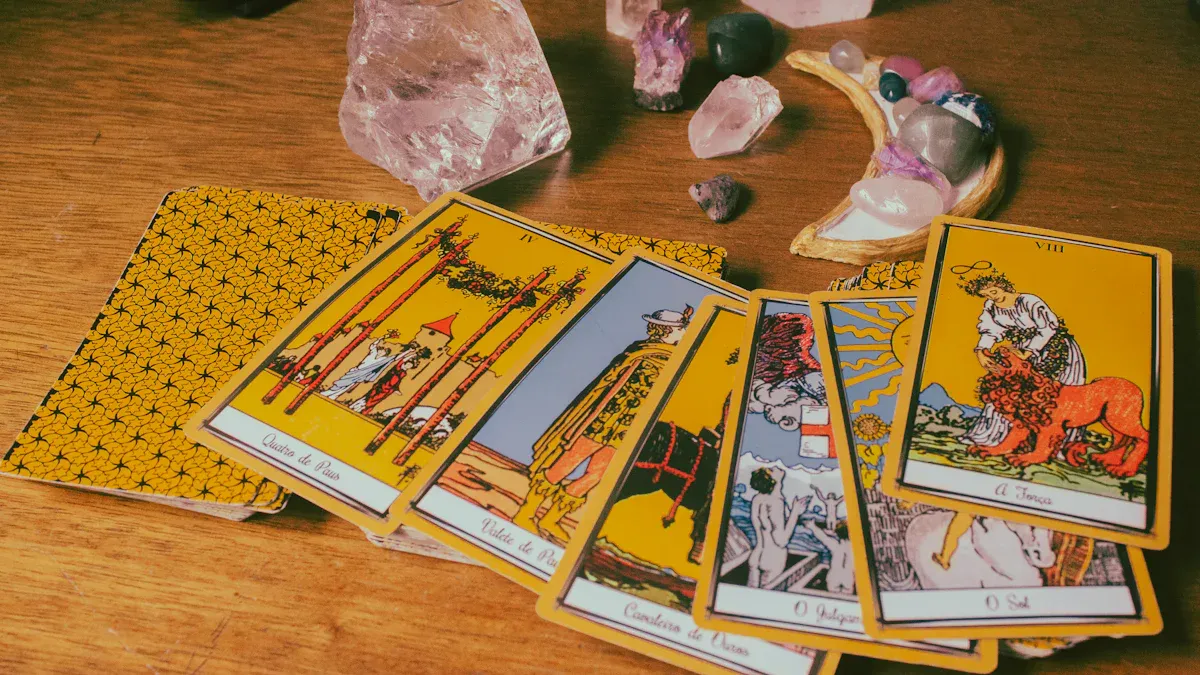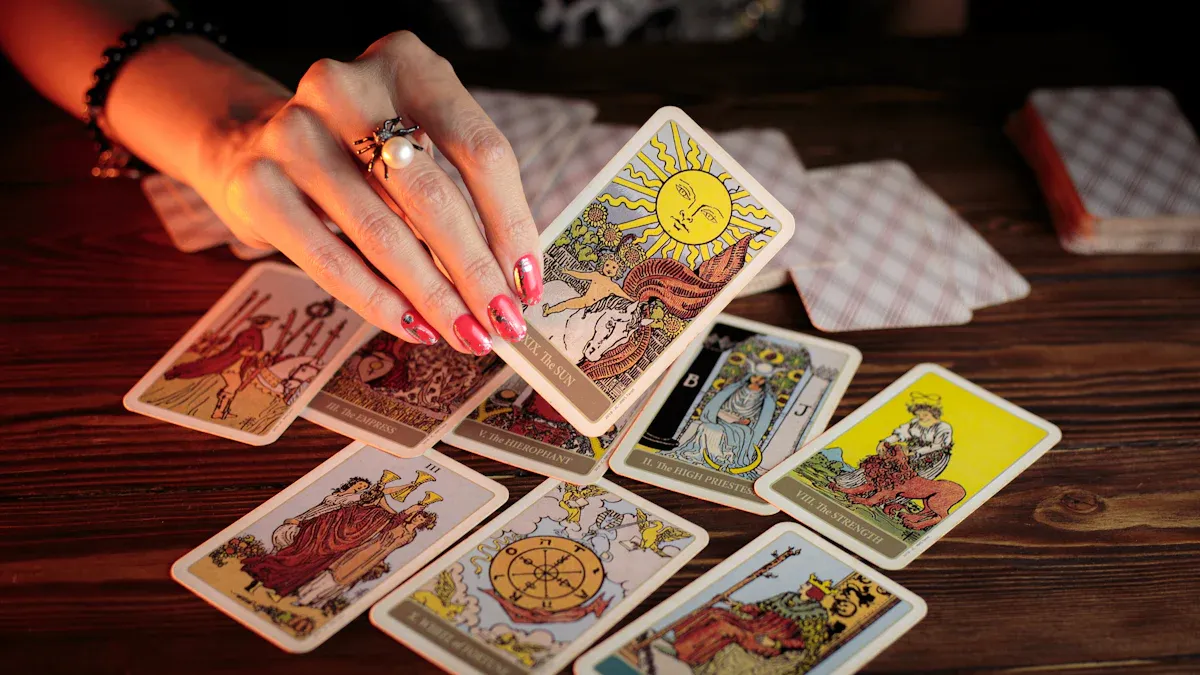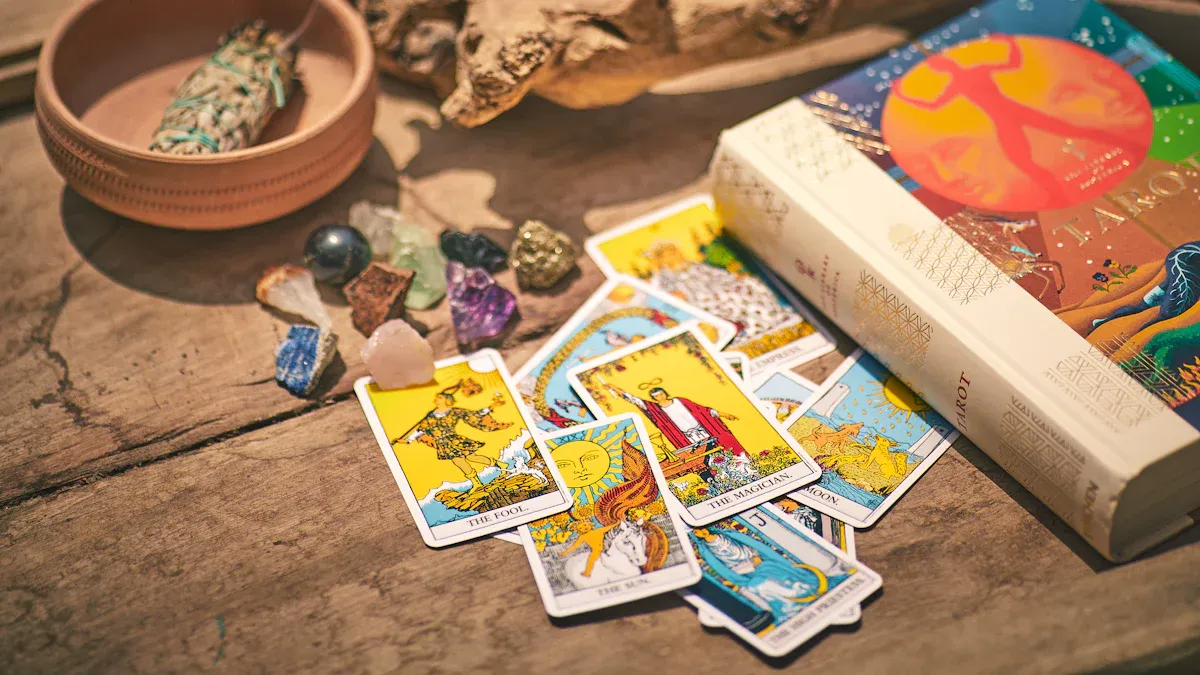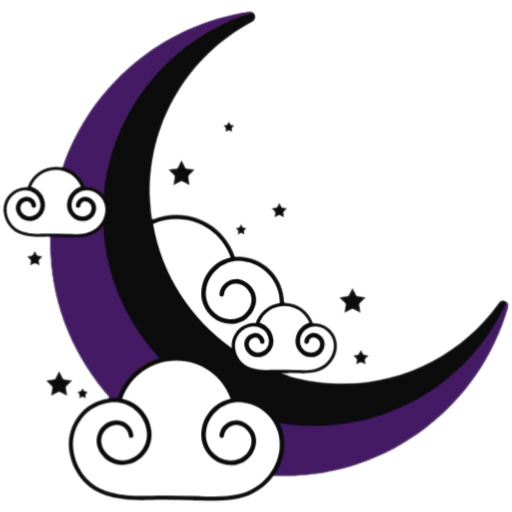
Understanding tarot cards is like learning a hidden language. Each card tells its own story. When you read them right, they share amazing insights. Without knowing their meanings well, your readings may seem messy or confusing.
A tarot card meanings list is like your map. It helps you understand and feel sure as you learn tarot. Whether you’re new or skilled, knowing the meanings is the secret to giving readings that make sense.
Key Takeaways
Knowing what tarot cards mean is important for clear readings. Each card shares a special story about feelings and life.
Use a list of tarot card meanings to help you. This list makes learning easier and helps you feel more sure as you practice.
Mix what you know about the cards with your gut feelings. This mix makes your readings better and more personal.
Don’t rush and think about the whole reading carefully. This helps you avoid mistakes and give correct meanings people can trust.
Check out books and online groups about tarot. These can teach you more and give you new ideas.
The Foundation of Accurate Tarot Readings

Why every tarot card tells a unique story
Each tarot card has its own special meaning. Think of them as storytellers sharing lessons about life. Some cards talk about love, while others show problems or chances. These meanings are not random—they connect to human feelings and events. For example, Major Arcana cards show big life lessons. Minor Arcana cards focus on daily life situations.
When reading tarot, your gut feelings bring the cards to life. Your instincts help you find the right meaning for the moment. This is why no two readings are alike. The same card can mean different things based on the question or person. That’s what makes tarot magical—it’s always personal and unique.
The value of a tarot card meanings list for beginners
Starting with tarot can feel tricky. There are 78 cards, each with its own meaning. A tarot card meanings list is like a helpful guide. It’s a quick way to learn what each card means.
For beginners, this list is super helpful. It gives you a simple way to start learning. You don’t need to remember everything right away. You can check the list whenever you need help. Over time, you’ll see patterns and connect ideas on your own. This makes you more confident and improves your readings.
How foundational knowledge builds confidence and precision
Learning tarot card meanings isn’t just about remembering them. It’s about creating a strong base of knowledge. When you know the basics, you feel more sure of yourself. This confidence makes your readings clearer and more meaningful.
Imagine trying to read a book in a language you don’t know. It would be hard, right? The same goes for tarot. Without knowing the meanings, your readings might feel messy. But when you understand the basics, everything makes sense. You can focus on the big picture and trust your instincts to fill in the details.
The Role of Intuition in Tarot Readings
Balancing intuition with tarot card meanings
Intuition is very important in tarot readings. It’s like a voice inside that helps you understand the cards better. But if you only use intuition, things can get confusing. That’s why knowing what the cards mean is so helpful. Think of card meanings as the base, and intuition as the spark that makes them shine. Together, they make readings feel clear and meaningful.
You don’t have to pick between intuition and knowledge. Use both together. First, learn the basic meanings of the cards. Then, as you practice, let your intuition add extra details. This teamwork makes your readings easier to understand and more helpful.
How understanding meanings enhances intuitive connections
Learning what tarot cards mean doesn’t stop your intuition—it makes it stronger. When you know the meanings, you can focus on the feeling of the reading. For example, the Three of Cups often means friendship or celebration. Knowing this lets you notice how it fits the person’s situation.
The more you study tarot, the more sure you’ll feel. This confidence helps your intuition work better. Over time, you’ll see how meanings and instincts mix to make readings that feel real and personal.
Avoiding the pitfalls of relying solely on intuition
Only using intuition can make readings unclear or wrong. Without knowing the card meanings, it’s easy to get things mixed up. This can leave you or the person you’re reading for feeling unsure.
To stop this, always use knowledge with your intuition. Think of meanings as a guide to keep you steady. When you mix this with your inner feelings, your readings become clearer and more accurate. This way, you build trust with others and feel closer to the cards.
The Consequences of Misinterpreting Tarot Cards

Common mistakes in interpreting tarot card meanings
Getting tarot cards wrong happens more than you think. A big mistake is focusing too much on one card. For example, the Death card might seem scary. But it often means change or new starts. If you skip the other cards, you miss the full story.
Another error is ignoring the question or situation. Each reading should match the person’s life. If you only use textbook meanings, readings can feel boring or off. Also, rushing through a reading can cause mistakes. Taking your time helps you see key details and avoid wrong ideas.
How misinterpretation affects trust and credibility
Wrong readings can make people lose trust in you. Imagine giving advice based on a wrong meaning. The person might feel confused or stop believing in tarot. Your skill as a reader depends on being clear and correct.
People look to you for help. If your readings feel wrong, they may doubt your ability. Over time, this can hurt your reputation. To keep trust, learn the cards well and give clear answers.
Tip: Always check your meanings and ask if they fit the reading.
The impact of inaccuracies on personal and spiritual growth
Tarot is more than just predicting things. It helps you learn about yourself and grow spiritually. Misreading cards can make you miss important lessons. This can slow your growth and leave you feeling stuck.
For example, The Tower card might seem all bad. But it often means needed change and growth. Good readings help you see problems as chances to improve. They guide you to learn more about yourself and your spiritual path.
Practical Tips for Mastering Tarot Card Meanings
Using a tarot card meanings list as a learning tool
A tarot card meanings list is like your personal cheat sheet. It’s a quick and easy way to learn what each card represents. When you’re just starting, this list can save you from feeling overwhelmed by the 78 cards in a deck. You can refer to it during your readings to ensure you’re on the right track.
To make the most of it, try organizing the list in a way that works for you. Some people group cards by suits or themes, while others prefer alphabetical order. Keep it handy during your practice sessions. Over time, you’ll rely on it less as the meanings start to stick in your memory.
Tip: Create your own meanings list by jotting down keywords or phrases that resonate with you. This personal touch can make learning more fun and meaningful.
Practicing daily card pulls and journaling interpretations
Daily card pulls are one of the best ways to connect with your tarot deck. Each morning, shuffle the cards and draw one. Take a moment to study it. What stands out? How does it make you feel? Write down your thoughts in a journal.
Journaling helps you track patterns and themes over time. For example, you might notice that certain cards appear when you’re facing challenges or opportunities. This practice not only improves your understanding of the cards but also strengthens your intuition.
Pro Tip: Start with small spreads, like a three-card layout. These are less intimidating and help you focus on how the cards relate to each other.
Exploring resources like books, courses, and online communities
Learning tarot doesn’t have to be a solo journey. There are countless resources available to help you grow. Books written by experienced readers can provide deeper insights into card meanings. Online courses often include video lessons and exercises to sharpen your skills.
Joining tarot communities, whether online or in person, is another great way to learn. You can share your experiences, ask questions, and even practice readings with others. These connections can inspire you and keep you motivated.
Did you know? Meditation and visualization can also enhance your tarot practice. They improve focus and help you form deeper connections with the cards.
Why Tarot Card Meanings Matter in 2025
Tarot’s growing role in self-discovery and modern spirituality
Tarot is now a big part of self-growth and understanding emotions. In 2025, more people use tarot to learn about themselves. It’s not just about predicting the future anymore. Instead, it helps people make better choices and understand their feelings. This change makes knowing tarot card meanings very important.
Research shows tarot connects deeply with people. For example:
A study found 55% of people felt tarot matched their lives.
The tarot market, worth $1.278 billion in 2023, is growing fast.
These facts show tarot is a key part of today’s spirituality. By learning card meanings, you can connect better with yourself and others.
How technology makes accurate readings more important
Technology has changed how we use tarot. Online readings are now very common. You can talk to readers worldwide or use apps for quick answers. But people expect these readings to be accurate and personal.
To meet these expectations, you must know the cards well. Understanding their meanings helps you give clear readings, even online. Digital tools like AI can help, but your card knowledge makes the reading special.
Adapting to querents’ needs in the digital world
In 2025, people want more than just answers from tarot. They look for advice that feels personal and helpful. Many use tarot for self-care, setting goals, or understanding emotions. Group readings are also popular, focusing on shared experiences.
To meet these needs, combine your card knowledge with empathy and intuition. This helps you give readings that inspire self-awareness. When you adjust to what people need, you build trust and make your readings meaningful.
Knowing tarot card meanings is crucial for clear and helpful readings. When you learn each card, you see how they connect in a story. Start with small spreads, like three cards, to stay focused and gain confidence. Writing in a tarot journal helps you notice patterns and track growth. Mixing what you know with your intuition makes your bond with the cards stronger and your advice more meaningful.
Tip: Follow your instincts but stick to the meanings too. This mix makes readings uplifting and powerful.
FAQ
What’s the best way to start learning tarot card meanings?
Start with a tarot card meanings list. Focus on one card daily and write down your thoughts in a journal. Use simple spreads like three cards to practice. Over time, you’ll notice patterns and feel more confident. 📚
Tip: Don’t rush! Let the meanings sink in naturally.
Can I rely only on intuition for tarot readings?
Not entirely. Intuition adds depth, but knowing the card meanings gives your readings structure. Think of meanings as the foundation and intuition as the creative spark. Together, they create accurate and insightful readings. ✨
How do I avoid misinterpreting tarot cards?
Take your time with each reading. Look at the cards as a whole, not just individually. Always consider the question or situation. If unsure, refer to your tarot meanings list or ask yourself if the interpretation feels right. 🃏
Are online tarot readings as accurate as in-person ones?
Yes, they can be! The key is your understanding of the cards and your ability to connect with the querent. Technology helps, but your knowledge and intuition make the reading meaningful. 🌐
How long does it take to master tarot card meanings?
It depends on your practice. With daily effort, you can build a solid foundation in a few months. Mastery takes time, but the journey is rewarding. Keep learning and trust the process. 🚀
Note: Consistency is more important than speed. Practice regularly!


